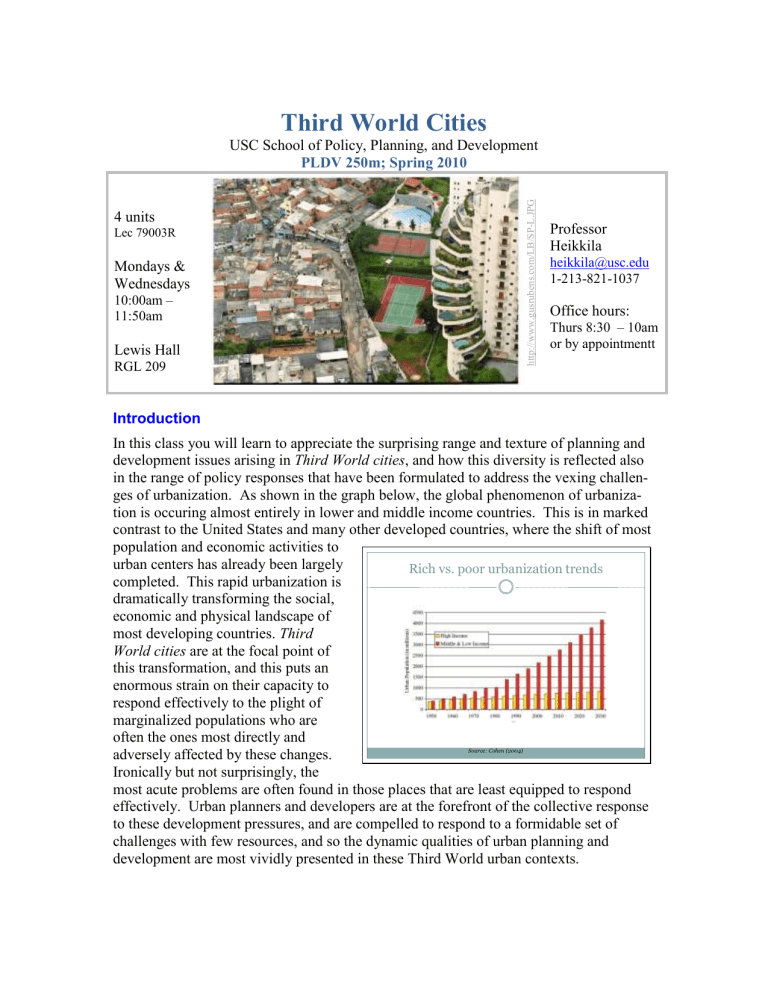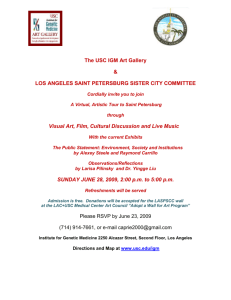Third World Cities

4 units
Lec 79003R
Mondays &
Wednesdays
10:00am –
11:50am
Lewis Hall
RGL 209
Third World Cities
USC School of Policy, Planning, and Development
PLDV 250m; Spring 2010
Professor
Heikkila heikkila@usc.edu
1-213-821-1037
Office hours:
Thurs 8:30 – 10am or by appointmentt
Introduction
In this class you will learn to appreciate the surprising range and texture of planning and development issues arising in Third World cities , and how this diversity is reflected also in the range of policy responses that have been formulated to address the vexing challenges of urbanization. As shown in the graph below, the global phenomenon of urbanization is occuring almost entirely in lower and middle income countries. This is in marked contrast to the United States and many other developed countries, where the shift of most population and economic activities to urban centers has already been largely completed. This rapid urbanization is dramatically transforming the social, economic and physical landscape of most developing countries. Third
World cities are at the focal point of this transformation, and this puts an enormous strain on their capacity to respond effectively to the plight of
Rich vs. poor urbanization trends marginalized populations who are often the ones most directly and adversely affected by these changes.
Ironically but not surprisingly, the
Source: Cohen (2004) most acute problems are often found in those places that are least equipped to respond effectively. Urban planners and developers are at the forefront of the collective response to these development pressures, and are compelled to respond to a formidable set of challenges with few resources, and so the dynamic qualities of urban planning and development are most vividly presented in these Third World urban contexts.
Heikkila; Third World Cities (PLDV 250m); last updated 4/18/2020
Diversity Statement
As a class that provides credit for USC's diversity requirement, PPD 250m focuses on diversity by defining and identifying development and urbanization in Third World cities that are culturally, geographically, economically, and historically diverse. The class also examines how characteristics such as gender, race, and income influence inhabitants’ roles in and experiences of development. This recognition is reflected in the philosophical and theoretical foundations of the notion of development.
The Human Development Indicators published for the past twenty years by UN
Habitat are an example of this, as are contemporary notions of “development as freedom” (Sen, 2002). Diversity manifests itself not only within Third World cities, but between them as well. Jakarta is as different from Nairobi as Shanghai is from São Paulo. As explained below, each student will conduct two substantial assignments focusing on a specific city. This will provide the class with a hands-on basis for understanding the diversity of Third World cities to supplement the course lectures and readings.
Course Content & Learning Objectives
The aim of this course is to produce students who can articulate planning and development principles as they apply in the context of Third World cities. These learning objectives are reflected in the five central modules exploring related sets of questions:
1.
Key terms and concepts
– What do we mean by “
Third World cities
”? How can the administrative, geographical, and socio-economic perspectives be reconciled?
Can this phenomenon be rigorously defined or measured? How has the notion of development evolved over the past fifty years, and what are the practical implications of these conceptual foundations?
2.
Is urbanization a good thing?
– What are the driving forces behind urbanization in Third World cities ? Should urbanization be encouraged or discouraged, and how? In particular, what is the causal relationship linking urbanization with indicators of developmental progress, and what evidence is there to support or refute such claims?
3.
Environmental justice and the city – How does ongoing urbanization in Third
World cities affect the plight of marginalized and at risk populations? What are the challenges for housing provisions, employment opportunities, infrastructure planning, environmental sustainability, and delivery of social services? What is the relationship between the formal and informal sectors?
4.
Institutional context of urbanization – What is the institutional context within which planners might respond to the challenges posed by urbanization in Third page 2
Heikkila; Third World Cities (PLDV 250m); last updated 4/18/2020
World cities? What role is there for international development agencies such as the World Bank? Can international NGOs play an effective role in fostering development? Are there any universal pre-requisites with respect to open markets, transparent legal systems, democratic political institutions, professional practice or cultural mores?
5.
Los Angeles as a Third World city – In this final module we turn our focus inward, to our own place. To what extent does Los Angeles qualify as a Third
World city (see Banerjee and Verma, 2002)? Are the same processes at work here? Does the extent to which residents experience Los Angeles as a Third
World city depend on gender, race, citizenship, income or other factors? Do the planning approaches advocated for Third World cities have relevance to Los
Angeles – or vice-versa?
Determination of your course grade
Your final grade will be determined through a combination of items, each of which contributes directly to the overall learning objectives of this course:
Class participation (10%) – While attendance and punctuality comprise one aspect of class participation, your grade will be determined also by the extent to which you make informed and constructive contributions to class discussions.
Assignment # 1: Profile of a Third World city (15%) – Each of you is asked to select a city early in the semester, to be used as a case study. In the first assignment you will prepare and present in class a profile of your city, drawing upon both quantitative and qualitative data.
Assignment # 2: Strategic plan for a Third World city (40%) – This is the most important assignment of the semester for you, where you are asked to produce a strategic plan that addresses the key challenges and opportunities of your city. The assignment comprises two parts: an in-class presentation (15%) of your preliminary ideas will enable you to receive feedback from me that you should then incorporate into your written essay (25%).
Assignment # 3: Los Angeles as a Third World city (15%)
– Many of the same phenomena (poverty, inequality, environmental degradation, institutional failures, informality) that characterize Third World cities can be found in developed countries as well. You will make an in-class presentation that illustrates these themes.
Final exam (20%) – This is scheduled for Monday, May 10 th
, from 8am – 10am
(See http://www.usc.edu/academics/classes/term_20101/finals.html
). The final exam provides an opportunity for you to demonstrate for me (and for yourselves) your mastery of the assigned readings and topics discussed in class.
Separate instructional materials will be provided for each of the assignments, noting formats, guidelines and due dates. page 3
Heikkila; Third World Cities (PLDV 250m); last updated 4/18/2020
Plagiarism
Any work you present for academic credit must be yours alone, with appropriate attribution to source materials you have used. The guidelines located at http://www.usc.edu/student-affairs/student-conduct/ug_plag.htm
are very helpful, and I strongly encourage you to review them carefully. The University penalties for plagiarism are tough, and rightly so, and they apply immediately upon the first instance. Please do the right thing and do not put me in a position where I am required to demonstrate our resolve on this point.
Readings and class schedule
Course readings are available on Blackboard ( https://blackboard.usc.edu/ ) along with related presentation materials. At a minimum you are expect to read and absorb the key readings corresponding to the lectures. You are also encouraged to draw upon supplemental readings, especially as you undertake your assignments. page 4




